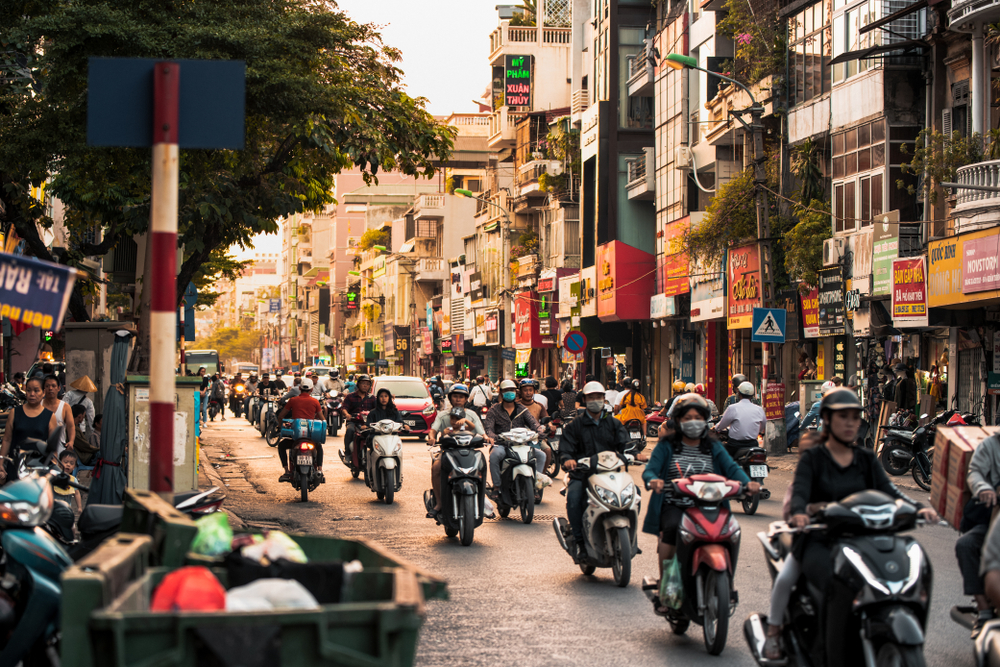Auto
Traffic in Vietnam is chaotic. Traffic accidents occur frequently and the most common victims are motorbike riders and pedestrians. At least 30 people die each day from transportation-related injuries and many more are injured, often with traumatic head injuries. Traffic accident injuries are the leading cause of death, severe injury, and emergency evacuation of foreigners in Vietnam. Traffic accidents, including those involving a pedestrian and a motorized vehicle, are the single greatest health and safety risk visitors will face in Vietnam.
Traffic moves on the right, although drivers frequently cross to the left to pass or turn, and motorcycles and bicycles often travel (illegally) against the flow of traffic. Horns are used constantly, often for no apparent reason. Streets in major cities are choked with motorcycles, cars, buses, trucks, bicycles, pedestrians and cyclos. Outside the cities, livestock compete with vehicles for road space. Sudden stops by motorcycles and bicycles make driving a particular hazard. Nationwide, drivers do not follow basic traffic principles, vehicles do not yield right of way, and there is little adherence to traffic laws or enforcement by traffic police.
The number of traffic lights in Hanoi and Ho Chi Minh City is increasing, but red lights are often not obeyed. Most Vietnamese ride motorcycles; often an entire family rides on one.
Poor Road Conditions
Road conditions are poor nationwide. Numerous tragic accidents have occurred due to poor road conditions that resulted in landslides, and tourists have lost their lives in this way. Travelers should exercise extra caution in the countryside, as road conditions are particularly poor in rural areas.
Driving at night is especially dangerous and drivers should exercise extreme caution. Roads are poorly lit, and there are few road signs. Buses and trucks often travel at high speed with bright lights that are rarely dimmed. Some motor vehicles may not use lights at all, vehicles of all types often stop in the road without any illumination, and livestock are likely to be encountered.
Motorcyclists and bicyclists are strongly urged to wear helmets. Passengers in cars or taxis should use seatbelts when available, but should be aware that Vietnamese vehicles often are not equipped with working seatbelts. A law mandating the use of motorcycle helmets on all roads went into effect on December 15, 2007, and is strictly enforced Child car seats are not available in Vietnam.
Penalties for driving under the influence of alcohol or causing an accident resulting in injury or death can include fines, confiscation of driving permits or imprisonment. Foreign citizens involved in traffic accidents have been barred from leaving Vietnam before paying compensation (often determined arbitrarily) for property damage or injuries.
Emergency roadside help is theoretically available nationwide by dialing 113 for police, 114 for fire brigade and 115 for an ambulance. Efficiency of these services is well below modernized standards, however, and locating a public telephone is often difficult or impossible. Trauma care is not widely available.
The urban speed limit ranges from 30 to 40 km/h. The rural speed limit ranges from 40 to 60 km/h. Both speed limits are routinely ignored. Pedestrians should be careful, as sidewalks are extremely congested and uneven, and drivers of bicycles, motorcycles and other vehicles routinely ignore traffic signals and traffic flows, and even drive on sidewalks. For safety, pedestrians should look carefully in both directions before crossing streets, even when using a marked crosswalk with a green "walk" light illuminated.
International driving permits and foreign drivers' licenses are not valid in Vietnam. Foreigners renting vehicles risk prosecution and/or imprisonment for driving without a Vietnamese license endorsed for the appropriate vehicle. Foreign citizens who wish to drive in Vietnam should contact any office of the Provincial Public Transportation Service of the Vietnamese Department of Communications and Transport to obtain a Vietnamese driver's license.
Emergency roadside help is available nationwide by dialing:
113 for police;
114 for fire; and
115 for ambulance.
Efficiency of these services is low and locating a public telephone is often difficult. Trauma care is not widely available.
Rental cars are available in large cities but are not recommended for any but experienced visitors. Cars with local drivers can be had for reasonable daily and weekly rates.
Source: US Department of State
Copyright © 1993–2025 World Trade Press. All rights reserved.

 Vietnam
Vietnam 
